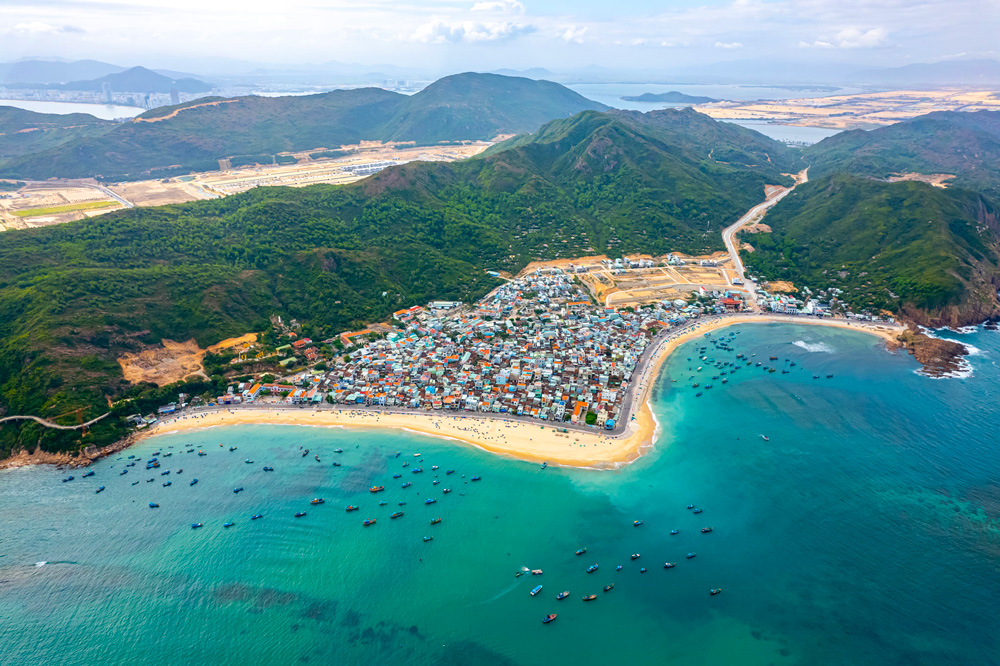How to get from Hoi An to Quy Nhon | Car, train, bus & moto
Are you looking for a peaceful and lesser-known beach destination in Vietnam? Quy Nhon is the place for you! This coastal city offers sunny beaches, picturesque landscapes, and delicious seafood-don’t miss trying their signature fish cake noodles. Located halfway between Da Nang and Nha Trang, it’s the perfect alternative to overcrowded tourist spots.
In this article, discover how to travel from Hoi An to Quy Nhon, whether by car, by train, by bus or through an adventurous motorbike ride across villages and mountains.
Distance Between Hoi An and Quy Nhon

The distance between Hoi An and Quy Nhon is approximately 280 kilometers by road, which takes 5 to 6 hours by car or bus, depending on traffic conditions and the chosen route. For motorbike riders, the journey might take longer, especially if you take time to enjoy the coastal landscapes and quaint villages along the way.
For those seeking a faster alternative, it’s possible to take a train or flight from Da Nang (near Hoi An) to Quy Nhon, though this requires transfers and connections.
Transportation Options Between Hoi An and Quy Nhon
| Mode of Transport | Duration | Price |
| Train | 5h30 to 6h30 | 330,000 VND to 1,200,000 VND |
| Bus | 6h | 415,000 VND to 600,000 VND |
| Private Car | 5h to 6h | 4,000,000 VND (4 seats) |
| Motorbike | 6h | 150,000 VND per motorbike |
| Airplane | No direct flights | – |
1. Train from Hoi An to Quy Nhon

In the absence of a train station in Hoi An, your journey begins with a transfer to Da Nang Railway Station. Several options are available for the Hoi An–Da Nang transfer. Feel free to read my full article on the Hoi An–Da Nang route | vice versa.
This route is part of the famous Reunification Express of Vietnam, an iconic railway line that traverses spectacular landscapes, from lush green rice paddies to dramatic coastal cliffs, while symbolizing the country’s historical unity.
Train ticket prices from Da Nang to Quy Nhon range from 335,000 VND to 10 million VND for the most luxurious options (The Vietage Train), depending on the seat type chosen.
Quy Nhon’s train station, called Dieu Tri Station, is located 13 km northwest of the city. It is therefore recommended to plan your transfer in advance. Many hotels in Quy Nhon offer pickup services from the station, which is especially convenient if you arrive late at night or stay in more remote areas like Bai Xep.
A taxi ride costs between 120,000 and 175,000 VND to reach Quy Nhon’s city center. Alternatively, a local bus runs hourly for just 5,000 VND, stopping at the Co-Op Mart on Le Duan Street.
Train tickets can be booked online via 12Go or Bao Lau, two reliable platforms for booking tickets, and an added bonus: they are available in French. You will receive an e-ticket by email, which can be presented at boarding either as a printed copy or directly on your phone or tablet.
Train Schedule and Prices
| Train | Journey Duration | Departure (Da Nang) | Arrival (Quy Nhon – Dieu Tri) | Price (VND) |
| SE21 | 6h 03m | 08:00 | 14:03 | 337,000 |
| SE5 | 6h 26m | 08:51 | 15:17 | 360,000 |
| SE3 | 5h 47m | 11:29 | 17:16 | 358,000 |
| SE3 VIP | 5h 48m | 11:29 | 17:17 | 1,187,500 |
| SE1 | 5h 31m | 12:47 | 18:18 | 381,000 |
| SE1 VIP | 5h 30m | 12:47 | 18:17 | 1,187,500 |
| SE7 | 5h 27m | 23:27 | 04:54 | 366,000 |
My Opinion on The Vietage Train

For a price close to 10 million VND, you would expect a luxury experience, but The Vietage Train clearly falls short. In reality, it’s just a renovated cabin at the back of a local train, which undermines the image of an exclusive service you might anticipate.
Comfort is limited: there isn’t much space to sit, and the air conditioning is barely effective, which can make the journey uncomfortable on hot days. Additionally, there’s a lack of small touches that could enhance the experience, such as magazines to read or personalized attention.
In terms of amenities, free Wi-Fi and functional power outlets are nice features, but they are standard in far cheaper options nowadays. As for the menu, it seems to cater to a very “tourist-oriented” taste-nothing particularly original or authentic.
In summary, The Vietage gives the impression of paying an exorbitant price for a product that doesn’t live up to its promises. If you’re looking for a true luxury experience or excellent value for money, this is probably not the ideal choice.
2. Bus from Hoi An to Quy Nhon

The bus journey from Hoi An to Quy Nhon is a popular option among tourists. On average, buses take about 6 hours to complete the trip. They depart early in the morning or late at night, often as sleeper buses.
Night buses are usually faster and more reliable than those operating during the day. Prices range between 415,000 VND and 600,000 VND. Among bus operators, I recommend An Phu Travel and Vietnam Travel Bus, which provide modern buses equipped with comfortable seats, Wi-Fi, and bottled water.
However, despite these options, I personally do not recommend taking buses in Vietnam. Drivers tend to adopt dangerous driving habits. I much prefer traveling by train or private car, which are safer transportation options.
Quy Nhon’s bus station is located in the southern part of the city, near the Metro supermarket. Nearby, the city station allows you to catch a bus to the city center for just 5,000 VND. Buses depart from the station every 30 minutes.
Bus Schedule and Prices
| Departure Time | Arrival Time | Journey Duration | Price (VND) |
| 09:00 | 15:00 | 6h | 600,000 |
| 10:00 | 16:00 | 6h | 866,667 |
| 10:30 | 16:30 | 6h | 826,667 |
| 11:00 | 17:00 | 6h | 615,500 |
| 14:30 | 20:30 | 6h | 756,000 |
| 17:00 | 23:00 | 6h | 415,500 |
| 17:30 | 23:45 | 6h 15m | 468,750 |
| 17:40 | 00:20 | 6h 40m | 512,500 |
| 17:45 | 00:25 | 6h 40m | 600,000 |
| 18:00 | 00:00 | 6h | 427,226 |
| 18:00 | 00:00 | 6h | 756,000 |
| 18:00 | 00:35 | 6h 35m | 402,600 |
| 18:30 | 00:30 | 6h | 565,229 |
| 18:45 | 00:45 | 6h | 562,500 |
| 19:30 | 01:30 | 6h | 500,000 |
| 21:00 | 06:00 | 9h | 350,000 |
3. Private Car

The car journey from Hoi An to Quy Nhon takes five to six hours. Along with motorbikes, it’s my favorite mode of transport in Vietnam.
The two main advantages of a private car trip are that you can leave at the time that suits you best and stop wherever you want along the way.
Additionally, this option includes convenient hotel pickup in Hoi An and drop-off at your desired location in Quy Nhon. There’s no hassle of checking train or bus schedules-you simply step out of your hotel, and the car is ready for you.
I can’t recommend Hoi An Transport Service enough, as it’s, in my opinion, the best car transport company in Hoi An. Their prices are often among the cheapest, fixed, and clearly displayed on their website. There’s no need to request a quote that varies depending on the client, as is often the case in Vietnam. And a big bonus: Olivier answers in English or in French! WhatsApp: +841238441732.
Prices for a Private Car from Hoi An to Quy Nhon
| Vehicle Type | Price (VND) |
| 4-seater car | 3,800,000 VND |
| 7-seater car | 4,000,000 VND |
Please note that the price of a private car includes fuel, toll fees, and parking charges, but excludes meals and entrance fees to attractions you may stop at along the way.
4. Flight from Hoi An to Quy Nhon
To put it simply, the nearest airport to Hoi An, Da Nang International Airport, does not offer direct flights to Quy Nhon. Therefore, any flight between these two destinations would require a significant detour through Hanoi or Saigon.
If you arrive in Quy Nhon by plane, plan for a taxi ride costing approximately 250,000 VND to get from the airport to the city center.
5. Motorbike from Hoi An to Quy Nhon

To freely explore all the attractions along the route from Hoi An to Quy Nhon, a motorbike is an excellent option. It’s actually an ideal mode of transport in this region.
Quy Nhon offers such a peaceful atmosphere that most streets lack-and don’t even need-traffic lights. Furthermore, many beaches and points of interest, which are often difficult to access, become much easier to reach with your own vehicle.
When traveling by motorbike, an essential question arises: Which route should you take from Hoi An to Quy Nhon? The highway or the coastal route?
– Highway from Hoi An to Quy Nhon

The journey along Highway 1 takes an entire day by motorbike or car. However, the route along the QL1A (or Highway 1) is incredibly easy to follow and well-marked in both directions. This makes it an excellent option if you want to get from Hoi An to Quy Nhon quickly and if the destination matters more to you than the journey.
Keep in mind, though, that it will still take five to eight hours of driving on a highway filled with trucks, motorbikes, and high-speed cars. The 300 km distance and heavy traffic should not be underestimated.
– Coastal Route from Hoi An to Quy Nhon (My Preferred Option)
The coastal route is longer, taking about two days, but it offers the additional advantage of being surrounded by untouched nature, blue lagoons, and scenic mountain passes. However, it’s impossible to completely avoid the highway, as parts of this route weave through it.
That said, the road primarily hugs the coast, winding through small, charming villages.

Itinerary from Hoi An to Quy Nhon
Step 1: From Hoi An to Tam Ky
- 1. Start your journey by crossing the Cua Dai Bridge.
- 2. Head south on the bridge and follow Route 129 to Tam Ky.
- 3. Optional Detour: Take Thanh Nien Road to explore the painted village of Tam Thanh.
Step 2: From Tam Ky to Chau O
- 1. From Tam Ky, join the QL1A highway, passing by Chu Lai Airport.
- 2. Turn left onto QL24B (Nguyen Tu Tan Street) to reach the small town of Chau O.
Step 3: From Chau O to Quang Ngai
- 1. Travel through small towns until you reach the coast.
- 2. Pass by the Chau Sa Citadel to arrive in Quang Ngai.
Step 4: From Quang Ngai to Quy Nhon
- 1. Take the QL1A highway to continue southward.
- 2. Join the DT627B, a road that runs along a wild coastline with kilometers of shrimp farms.
Step 5: Exploring the Coastal Detour (DT639)
- 1. Follow the DT639, which serves as the main coastal detour:
- • Travel through picturesque villages.
- • Cross endless bridges.
- • Climb a mountain pass to reach Lo Dieu Beach.
Step 6: Arrival in Quy Nhon
- 1. The DT639 connects to the DT632, then to the DT640.
- 2. Enter Quy Nhon through a newly developed urban area.
Attractions Between Hoi An and Quy Nhon
Above all, part of the joy of traveling from Hoi An to Quy Nhon is the journey itself. Don’t miss some of the beautiful attractions along the way.
Cham Towers of Chien Dan

The Chien Dan Cham Towers, located near the town of Tam Ky, were built in the 10th and 11th centuries. This area was once part of the Champa Kingdom nearly 900 years ago.
The three towers, all with entrances facing east, give the impression of a lost ancient city. They are also a marvel of engineering, using innovative construction techniques. Interestingly, the Cham builders did not use mortar for their structures, instead relying on interlocking baked bricks.
While many statues have been relocated to a small nearby museum, there is still plenty to see. For example, two of the towers have lost their roofs over time, and crumbling bricks can be found around the grand ancient entrances. But this adds to the charm of the Chien Dan Cham Towers.
Located 9 km north of Tam Ky, the towers can be seen when traveling along the QL1A highway from Hoi An to Quy Nhon.
Tam Thanh Mural Village

A peaceful coastal fishing village, completely transformed by artists who have turned the facades of over 100 residential houses into stunning works of art. In other words, the village has come to life through its murals. Today, it has become an open-air art gallery that is absolutely breathtaking and ready to be explored.
The murals adorning the village perfectly capture its essence and soul: children playing in the streets, fishermen in the ocean, and even locals proudly posing in front of their own portraits. As a bonus, these artworks provide fantastic backdrops for memorable photos.
My Lai Historical Site
This historical site is located in the small village of My Lai, 14 km east of Quang Ngai city center. The My Lai Historical Site tells the harrowing story of the murder of over 500 Vietnamese people in 1968. Visitors can walk through the memorial park and the small nearby museum, which primarily consists of household remnants from this massacred village. The memorial itself lists the names of the 504 victims, ranging in age from one to eighty-two years old.
At the time, American soldiers killed unarmed civilians, including women, children, and the elderly, all within less than five hours. Unsurprisingly, this tragedy continues to haunt many residents of My Lai today. Take your time to walk through the site, read the plaques in front of the old abandoned huts, and learn more about the history and its impact on the small village of My Lai.
The My Lai Memorial (Son My) is about a two-and-a-half-hour drive without stops from Highway 1 in Quang Ngai province, approximately 130 km from Hoi An on the way to Quy Nhon. Entry to the site costs 15,000 VND, including a 5,000 VND parking fee. The site is open from 7 AM to 5 PM, and you can expect to spend about two hours exploring the area.
My Opinion
As mentioned earlier, my preference goes to traveling by motorbike or car.
Driving along the coast from Hoi An to Quy Nhon is an absolute pleasure. You can stop in little-known fishing villages, which, for me, was the most memorable aspect of this journey.








